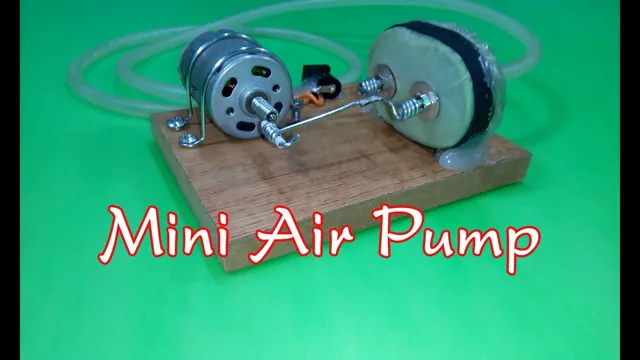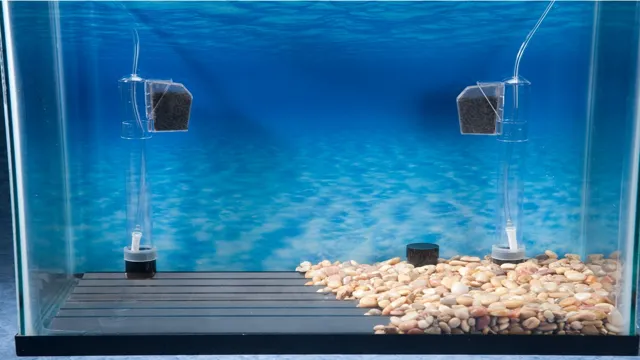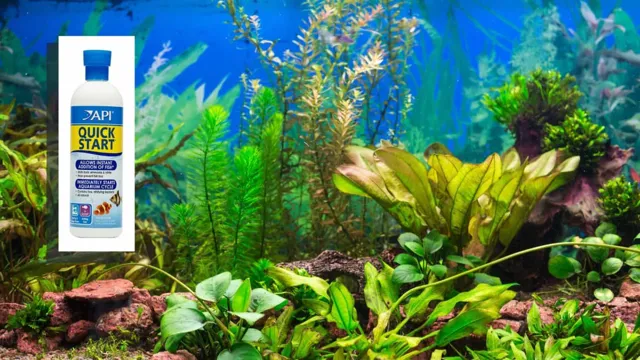If you’re an aquarium enthusiast, you know that a well-functioning air pump is essential for keeping your fish healthy and happy. However, commercial air pumps can be expensive and complicated to set up. The good news is that you can easily create a simple air pump for your aquarium with just a few household items and a bit of DIY know-how.
In this blog post, we’ll guide you through the process of creating an air pump that will keep your aquarium aerated and your fish thriving. Not only will you save money, but you’ll also have the satisfaction of creating something useful and practical with your own hands. So, roll up your sleeves and join us as we dive into this fun and easy project.
Without further ado, let’s get started on creating a simple air pump for your aquarium that will keep your fish swimming happily.
Gathering Materials
If you’re looking to make a simple air pump for your aquarium, you’ll need to gather a few materials first. The most important item you’ll need is an air stone, which will disperse the air bubbles evenly throughout the tank. You’ll also need some airline tubing to connect the air stone to the pump, and a check valve to prevent water from siphoning back into the pump.
For the pump itself, you have a few options. You could use a battery-operated air pump, which is portable and easy to use, but may not be as powerful as an electric pump. Alternatively, you could use a manual pump, such as a bicycle pump or hand pump, but these require more effort to operate.
Whatever pump you choose, be sure to follow the manufacturer’s instructions and safety guidelines, and test your system before adding it to your aquarium. With a little ingenuity and the right materials, you can create a simple and efficient air pump for your aquarium that will keep your fish healthy and happy.
Materials Needed:
When it comes to any kind of project, gathering materials is an important first step. In order to get started, you’ll need to figure out exactly what you’ll be needing and then find a way to get your hands on it. Depending on what you’re working on, this might be a quick and simple process or a more involved one.
You may need to make a trip to the store, or maybe you already have everything you need on hand. Whatever the case, make sure you take the time to gather all of your materials before beginning your project. This will help you avoid any unnecessary delays or frustration once you get started.
So whether you’re working on a new sewing project, putting together a piece of furniture, or tackling a home renovation, take the time to gather all the materials you’ll need before diving in.

– Air tubing
When it comes to setting up an aquarium, one of the essential materials that you need is air tubing. This thin, flexible tube allows air to flow from the air pump into the aquarium, providing much-needed oxygen for your aquatic pets. But not all air tubing is created equal.
Make sure to select air tubing that is made from durable materials and is the appropriate diameter for your air pump. The wrong size tubing can cause inefficiencies in your aquarium’s oxygenation process, leading to potential problems for your fish, plants, and other inhabitants. To ensure that you are getting the best air tubing for your needs, do your research and read reviews from other aquarium enthusiasts.
By taking the time to select the right air tubing, you can rest assured that your aquarium is running smoothly and your aquatic pets are thriving.
– Air stone
When it comes to setting up a successful aquarium, there are several essential materials that you need to gather, and one of them is the air stone. Air stones or diffusers are devices that inject air into your aquarium, promoting better circulation, and oxygenating the water. They also help improve the health of your fish by providing bubbles that support a healthy gas exchange at the water surface, which removes harmful gases and provides the necessary oxygen levels.
When looking for an air stone, there are various designs and sizes to choose from, but the most common types are cylindrical, small puck-like stones, and linear air stones. Ultimately, your choice of the air stone depends on your aquarium’s size and the kind of fish you want to keep. A larger aquarium may require more than one air stone to cater to the tank’s capacity, while smaller aquariums require a single air stone.
Also, consider the shape of your aquarium when buying an air stone because a round aquarium will require a different type of diffuser than a tank with corners. Overall, gathering an air stone is a fundamental step when creating your aquarium, and selecting the best one will be crucial for maintaining a clean and healthy environment for your aquatic pets.
– Check valve
When it comes to setting up a plumbing system, a check valve is a crucial component that you’ll need. This valve helps prevent backflow in the system by allowing liquid or gas to flow in only one direction. Often made of durable PVC material, a check valve can withstand high pressure and harsh environmental conditions. (See Also: How to Cut Thick Aquarium Glass Without Damaging It: A Step-by-Step Guide)
To install a check valve, you’ll need to have the necessary materials on hand. These include PVC cement, pipe cutters, a measuring tape, and sandpaper. It’s important to ensure that all measurements are accurate and that the surfaces are smooth before cementing the valve in place.
By taking the time to gather all the necessary materials and ensuring that the installation is done correctly, you can be confident that your plumbing system will function efficiently and effectively.
– Air pump
When it comes to setting up your aquarium, one essential piece of equipment you’ll need is an air pump. This device helps maintain a healthy environment for your aquatic pets by creating air flow in the water. Before selecting an air pump, you’ll need to consider the size of your aquarium and the types of fish and plants you have.
A larger aquarium with a lot of plants will require a more powerful air pump than a smaller one with fewer plants. Additionally, think about the noise level and durability of the pump you choose. You don’t want a loud pump disturbing your serene aquarium atmosphere, and you want a pump that will last a long time.
Don’t forget to also gather the necessary tubing and air stones to complete your setup. With the right air pump and accessories, your aquatic ecosystem will thrive.
Step-by-step Instructions
Are you tired of spending money on expensive air pumps for your aquarium? Why not make your own simple air pump! Here’s how you can do it easily. First, you will need a plastic bottle, an air stone, airline tubing, and a hand-held balloon pump. Start by drilling a small hole on the side of the bottle, near the bottom.
Insert the airline tubing into this hole, and attach the air stone to the other end of the tubing. Next, attach the balloon pump to the other end of the airline tubing. Now, fill the bottle with water, leaving a bit of space at the top.
Finally, pump the balloon pump to create air bubbles in the water. These bubbles will create enough oxygen for your fish to breathe. And voila! You’ve created your very own simple air pump for your aquarium without breaking the bank.
Just make sure to check the pump regularly to ensure it’s working efficiently.
1. Attach one end of the air tubing to the air stone and the other to the air pump.
If you’re setting up an aquarium, one of the essential things you’ll need is an air pump to provide the necessary oxygen. Attaching an air stone correctly is a crucial step in ensuring your aquatic pets stay healthy. To start, grab the air tubing and attach one end to the air stone and the other to the air pump.
Ensure the air tubing is the right size to fit snugly onto both the pump and stone. The air stone needs to be fully submerged in the water, so place it at the bottom of the aquarium in a location where the bubbles it releases will move the water efficiently. A good tip is to cover the air stone with sand or gravel so that it doesn’t move around.
The air pump must be placed above the aquarium to prevent any water from seeping into the mechanism and damaging it. Once you’ve attached the tubing, plug in the air pump and enjoy the sight of bubbles circulating in the water. With just this simple step, you’re well on your way to providing a healthy aquatic environment for your beloved pets and plants.
2. Connect a check valve to the middle of the tubing to prevent water from entering the air pump.
If you’re setting up an aquatic system, it’s important to prevent water from entering the air pump. This can be done easily by connecting a check valve to the middle of the tubing. Here are some step-by-step instructions on how to do this.
First, cut the tubing to the appropriate length and attach one end to the air pump. Then, insert the check valve into the middle of the tubing and connect the other end to the rest of the system. The check valve allows air to flow through in one direction, preventing water from backing up and entering the pump.
This not only protects the air pump but also helps to maintain the overall health of your aquatic system by preventing water contamination. So, don’t forget to add a check valve to your tubing for a smooth and worry-free setup. (See Also: How to Grow Dwarf Baby Tears Outside Aquarium: Tips and Tricks)
3. Place the air stone in the bottom of the aquarium and make sure the other end of the tubing is outside the tank.
If you’re setting up an aquarium, one important step is to place the air stone in the bottom of the tank and make sure the tubing is positioned outside the container. This process helps improve the quality of the water by increasing the oxygen levels. Air stones are porous objects that attach to an air pump and release tiny bubbles into the water to improve circulation.
It’s crucial to select an appropriate size for your aquarium because too small or large stones can be ineffective. An excellent method to ensure an optimal location is to place an air stone in the aquarium’s corner and away from the direct heat source. This process will help promote even distribution throughout the tank and improve aeration and water circulation.
After the air stone is in the appropriate location, ensure the tubing remains tight around it to prevent air leaks. Check regularly for leaks and remove the tubing from the air pump when changing water to avoid electric shock. With proper installation and maintenance, an air stone can help create a lively and healthy environment for your aquatic inhabitants.
4. Plug in the air pump and adjust the airflow as needed.
Plug in the air pump and adjust the airflow as needed to keep the aquarium environment healthy for your fish. It’s essential to maintain the proper balance of oxygen and carbon dioxide in the water to ensure that your fish are getting enough oxygen to breathe. Once you’ve assembled your air pump, you’ll need to plug it in and turn it on.
Adjust the airflow using the control knobs until you get the desired amount of bubbles in the water. If the bubbles are too small, increase the airflow, and if they are too large, decrease the airflow. Remember to regularly check the airflow and adjust as needed to keep the water oxygenated properly.
Don’t forget to follow the manufacturer’s instructions and safety precautions when using your air pump to keep your aquarium environment healthy and safe.
Tips for Maintenance and Safety
If your aquarium isn’t equipped with an air pump, you’ll need to consider investing in one to keep your fish healthy. Alternatively, if you’re interested in a DIY option, you can create a simple air pump for your aquarium. To build a simple air pump, you’ll need a few items: a plastic bottle, a plastic tube, an airstone, and a pump.
First, poke holes in the bottle’s cap and thread the tube through it. Next, attach the airstone to the opposite end of the tube and connect the pump to the tube’s other end. The pump works by pushing air through the tube and to the airstone, creating bubbles in your aquarium.
When it comes to maintaining your new air pump, keep the tube clean to prevent buildup and replace the airstone regularly. Safety is also an important consideration: always unplug the pump before conducting maintenance, and keep it away from water to avoid electrical shocks. With these tips in mind, you’ll be able to enjoy a healthy and thriving aquarium in no time.
– Regularly clean the air stone to prevent clogging.
Regularly cleaning the air stone in your aquarium is essential for preventing clogging and maintaining a healthy environment for your fish. Over time, debris and algae can build up on the surface of the stone, hindering its ability to produce air bubbles and disrupting the balance of oxygen in the water. To prevent this from happening, it’s recommended that you clean your air stone at least once every month or two.
This can be done by soaking the stone in a 50/50 solution of vinegar and water for a few hours before scrubbing it with a soft-bristled brush. Alternatively, you can replace the stone altogether if it becomes too clogged or damaged. Taking these simple steps can help ensure the longevity of your aquarium and the health of its inhabitants.
– Always unplug the air pump before touching or cleaning it.
Maintaining your aquarium is essential to keeping your fish healthy and happy. However, while cleaning your tank and equipment, it’s vital to prioritize safety to avoid damaging the equipment or hurting yourself. One of the tips for maintaining your aquarium is to always unplug the air pump before touching or cleaning it.
This simple but crucial step can prevent electrocution and damage to your pump. Additionally, when cleaning any item in your aquarium, be gentle and use mild detergents to avoid harming your fish. Remember also to clean tank decor regularly, remove excess dirt and waste, change the water, and replace the filter media when necessary.
By following these maintenance tips and taking safety precautions, you can have a thriving aquarium that you, your family, and your fish will enjoy. (See Also: How to Deal with Aggressive Fish in Aquarium: Tips and Techniques)
– Make sure to securely fasten the tubing and check valve to prevent leaks.
When setting up a tubing system, it’s essential to ensure that everything is securely fastened and properly installed to prevent any potential leaks. A leaky tubing system not only compromises the efficiency of the system, but it can also be dangerous. When dealing with fluids, it’s important to prioritize maintenance and safety.
Leaks can lead to accidents and spills, which can be detrimental and even hazardous to both people and the environment. To avoid these risks, use high-quality tubing and check valves and make sure that they are correctly installed and maintained. It’s also important to inspect the tubing system regularly for any signs of wear and tear, and to replace any damaged parts as soon as possible.
By taking these measures, you can ensure a safe, efficient, and reliable tubing system for all of your fluid handling needs.
Conclusion
In conclusion, making an air pump for your aquarium is as easy as blowing bubbles in a glass of milk. With just a few simple materials like a plastic bottle, a tubing, and an air stone, you can provide your fish with the oxygen they need to live comfortably and swim happily in their aquatic home. So don’t be afraid to DIY your way to a better aquarium, because with a little creativity and ingenuity, you too can become a master of underwater aeration.
Happy tinkering!”
FAQs
What are the materials needed to make a simple air pump for an aquarium?
You will need a plastic bottle, airline tubing, an airstone, and an air pump.
Is it necessary to use an air pump in an aquarium?
Yes, an air pump provides oxygen to the aquarium and helps keep the water circulating.
How can I make an air pump without an air pump machine?
You can make a DIY air pump using a water bottle and a balloon. Attach the balloon to the top of the bottle and pump the balloon to create air pressure in the bottle.
Can I adjust the air flow in my aquarium?
Yes, you can adjust the air flow rate by adjusting the airflow control valve of your air pump.
How often should I clean the airstone in my aquarium?
Airstones should be cleaned every two to four weeks to ensure proper air flow and prevent clogging.
Where should I place the air pump in my aquarium?
The air pump should be placed in a dry area, ideally above the aquarium, so water cannot flow back into the pump.
Can I use a regular water pump as an air pump in my aquarium?
No, water pumps are not designed to pump air and may damage your aquarium if used as an air pump.







